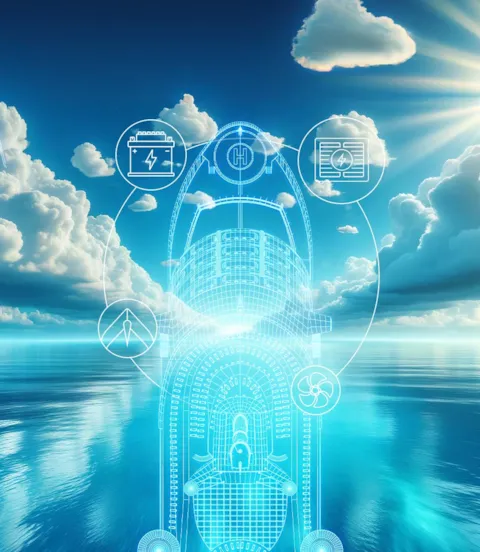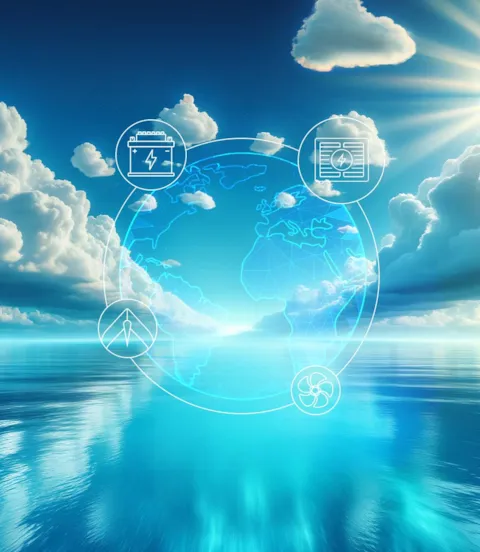Exploring next-gen energy efficiency technologies for cruise ships
Many leading cruise ship owners have invested heavily in making their fleets more energy efficient, aiming to mitigate future, potentially higher fuel expenses and reducing emissions. But how can they move the dial further? Antonio Prestigiacomo, Business Development Manager North America at DNV, sheds light on some promising energy-saving technologies currently being explored.
The cruise industry has made significant efforts to optimize operations for greater environmental and commercial sustainability. However, with the advancement of new successful technologies in other ship segments, there remains significant untapped potential for further cost and emission reductions within the cruise sector.
DNV Maritime Advisory has established a dedicated global cruise segment expertise team, drawing upon the company’s extensive experience in the broader maritime industry. Our experts are actively utilizing their knowledge and expertise in energy efficiency to support the cruise sector in their decarbonization initiatives.
A key insight is that technologies such as ship management system modeling and simulation, propulsions power optimization, bulbous bow optimization, and onboard fuel cells – whether employed individually or in combination – have the potential to drive energy savings. These savings directly translate into proven reductions in fuel consumption and carbon emissions, thereby lowering operational costs and improving cruise ships’ Carbon Intensity Indicator (CII rating).
1: Modelling and simulation for improving cruise ship energy efficiency
Modelling and simulation can comparatively assess and optimize the performance of complex machinery systems. Such systems consist of conventional components (e.g. engines, propellers, electrical devices) and new technologies like fuel cells and carbon capture units.
Quantifying how complex systems holistically respond to external factors (e.g. weather, route, speed and load) enables design, operation and maintenance optimized for energy efficiency to cut fuel consumption and emissions.
Past studies have demonstrated up to 10% efficiency improvements using simulation-based optimization of cruise machinery systems.
COSSMOS tool enables deep analysis of complex ship systems
DNVs Complex Ship Systems Modelling and Simulation (COSSMOS) platform is specifically developed to evaluate the energy efficiency, environmental performance, safety and reliability of ship machinery systems.
The tool facilitates the performance evaluation of new technologies that lower emissions and fuel consumption (e.g. fuel cells, carbon capture and batteries).
DNV’s COSSMOS tool has been in use for many years in other shipping sectors and is now being used in the cruise industry as a next step to conserve energy in operations.

2: Optimizing cruise newbuilds to use less propulsion power
Cruise ships operate at speeds determined by their destination schedules, and often operate outside their design condition. Hence, designing and building ships to a specified speed with the installed power does not guarantee efficient operation in service.
However, reducing the energy required for propulsion, the largest power consumer on a cruise ship, directly translates into less fuel use and reduced carbon emissions.
Optimizing the newbuilding vessel design can have significant benefits for fuel efficiency. When applied early in the newbuild process, it will have little or no impact on building expenses.
Reducing propulsion energy with computational fluid dynamics
DNV has developed an efficient process based on parametric modelling and systematic formal optimization, and computational fluid dynamics. This process simulates propulsion power and efficiency in anticipated operating conditions for thousands of candidate designs. Ultimately, it identifies the optimal design choice tailored to the vessel’s expected range of operating conditions.
The DNV process has been applied on several hundred newbuild projects across various vessel segments, including cruise.
As one example, using DNV’s unique optimization technology led to an optimized hull design that uses 10% less fuel than the starting design for Hapag Lloyd’s expedition cruise vessels.

3: Optimizing existing cruise ships for less power consumption
Modifying hull shape is unsuitable for existing designs. Moreover, with fuel prices high, operating conditions have changed substantially and typically involve much lower speeds than the ship was initially built for. This renders existing hulls unsuited to today’s operational demands.
Nonetheless, it is still efficient to optimize the most hydrodynamically prominent ship parts, the bulbous bow and the propeller.
In more than 150 projects, DNV has identified substantial fuel and emissions savings by modifying just the bulbous bow for various design retrofits (see graphic below).

4: Fuel cells show energy-saving potential for cruise ships
Traditional cruise ships need 10–100 MW of power for propulsion, lighting, air conditioning and on-board amenities. Today, it is usually generated by on-board diesel or gas generators, though some ships can now take shore power at some ports.
Fuel cells, a clean power-generation technology when produced from renewable energy sources, are already used on land for applications like data centres. Some cruise ship owners are piloting on-board 1–5 MW fuel cells to further explore their potential to boost energy efficiency and reduce emissions.
The future energy-saving potential of fuel cell technology in maritime applications, particularly for cruise ships, is significant. This potential is derived from several key attributes of fuel cells compared to conventional marine propulsion and power generation systems, including higher efficiency by direct conversion of fuel to electricity, reduced energy waste, zero emission potential and enhanced operation flexibility.
Developing solutions for safe on-board storage and more
Challenges to realize these savings include the need for safe on-board storage and use of large volumes of hydrogen or other fuels. A refueling infrastructure in ports also needs to be established. However, driven by stricter environmental regulation and growing demand for sustainable shipping practices, the maritime industry is developing solutions to overcome these hurdles.
DNV is currently involved in several fuel cell projects across various ship segments, including cruise ships, with promising results so far on energy savings and emissions reductions.

Conclusion
Summing up, it’s evident that technologies like ship management system modeling and simulation, propulsion power and bulbous bow optimization, and fuel cells - whether utilized independently or in combination - can significantly contribute to energy savings for the cruise ship segment.
- Ship management system modeling and simulation can improve energy efficiency by providing crucial insights into a cruise ship's operations, and quantifying emissions and fuel usage.
- Our extensive experience from client newbuilding projects demonstrates that optimizing propulsion power is a proven and effective energy-saving measure for cruise ship newbuilds, and incurs minimal costs when implemented early in the design phase.
- In cruise retrofits, modifying hydrodynamic parts such as the bulbous bow shows great potential for significant fuel and emissions savings.
- Ongoing advancements in fuel cell technology indicate potential for increasing energy efficiency and reducing carbon emissions for both existing fleets and cruise newbuilds.

Antonio Prestigiacomo
Director Cruise Center
- Shutterstock / Shutterstock.AI
- DNV
- Shutterstock – Shutterstock.AI/Suvit Topaiboon
- Shutterstock – Shutterstock.AI/Inkoly
